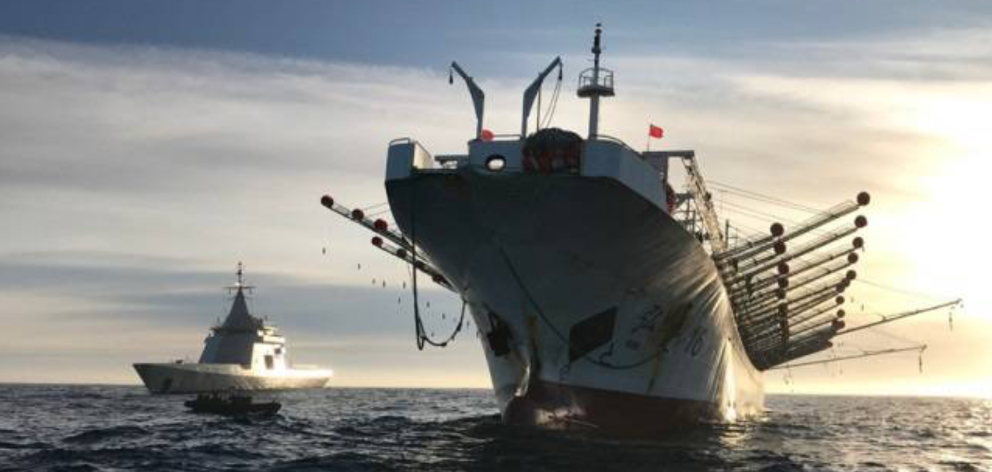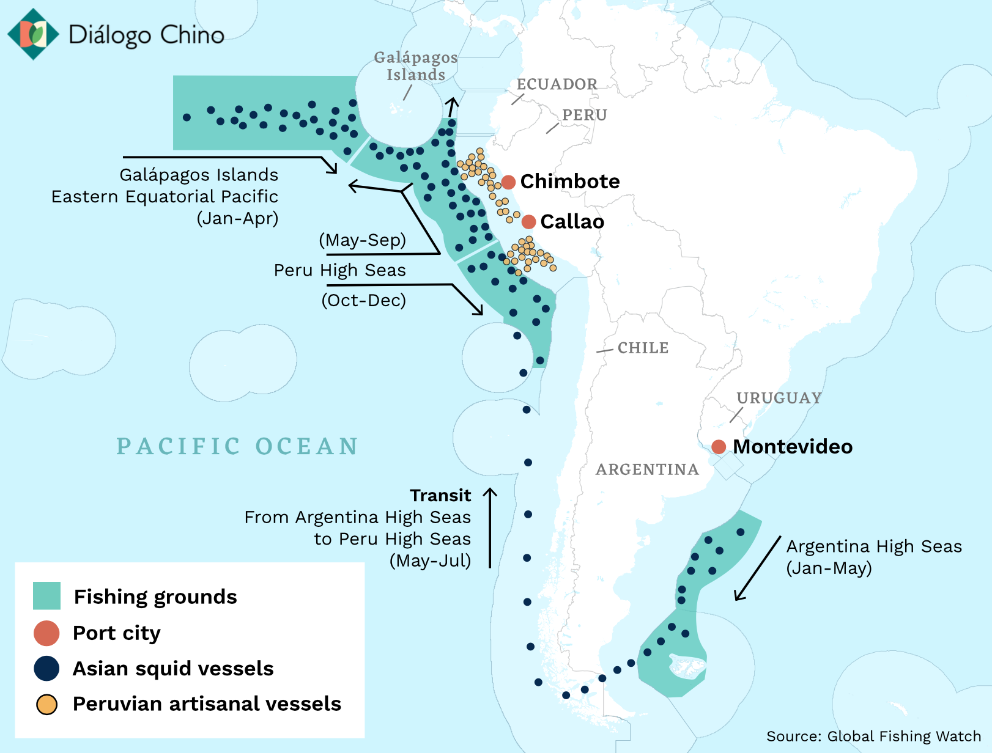Increase in Chinese fishing fleets prompts complaints of alleged encroachment into exclusive economic zones and illegal activity
° The presence of more than 500 vessels creates concern due to continued radar evasion, use of non-permitted extraction systems and disobedience of the coast guard.
° The governments of Chile, Colombia, Ecuador and Peru issued a statement calling for the supervision of an activity that Beijing refuses to submit to international inspection.
° Intimidation is reminiscent of the use of Chinese fishermen as a "shock force" in the South China Sea; here the goal is not to gain sovereignty, but to gain fishing space.

► The Chinese vessel Hong Pu 16, followed by the Argentine patrol vessel ARA Bouchard, in May 2020 [Argentine Navy].
report SRA 2021 / Paola Rosenberg [PDF version]
MAY 2021-Several Latin American countries have complained over the past year about Chinese economic predation, due to the massive presence of Chinese fishing vessels in the vicinity of their Exclusive Economic Zone (EEZ) and the poaching that has occurred there. They have also denounced the use by Chinese fishing vessels of unauthorized fishing techniques that deplete the main fishing grounds and erode marine sustainability.
The arrival from China of fishing vessels of what is normally categorized as Distant Water Fleet (DWF) began to occur in the Latin American maritime contour in 2001 with about twenty ships; since then the issue has been increasing rapidly and the most recent figures speak of about 500 ships. The discomfort of the most affected countries is not new, but in 2020 the complaints were louder and more formal. Moreover, in the open era of confrontation with Beijing, Washington came out in defense of the interests of its hemispheric neighbors.
China has the world's largest offshore fishing fleet, which is expanding as the fleets of other fishing countries are shrinking. The Issue is not clear, as it often operates through small front companies that blur its national origin, but it has been estimated to total 17,000 vessels. In this activity far from China itself, the fleet catches two million tons of fish, which is 40% of the world total in distant waters. Part of its catches are the result illegal fishing; China is the country with the worst record in the world in terms of illegal fishing practices, according to the Global Initiative evaluation .

Map taken from China Dialogue and Global Fishing Watch
The strategic Galapagos
Fishing is one of the most important resources for several Latin American countries, hence the massive Chinese presence in the vicinity of their exploitation waters, if there has been no penetration in them, has generated concern. In the last year there have been many reports of Chinese fishing off Ecuador, Peru, Chile and Argentina, especially linked to the capture of squid, but also of other species such as jack mackerel, mackerel, tuna and southern hake. These countries believe that there is overfishing and the capture of endangered species, such as the giant squid, with the consequent threat to the preservation of fishing wealth and biodiversity; in addition, they believe that there is also the possession of false licenses and the violation of the sovereignty of the coastal states by presumably illegally entering their EEZ. Fishermen from these coastal countries increasingly report the presence of Chinese vessels in an intimidating attitude, carrying out acts that threaten not only their natural resources but also their safety.
The main accusations began in July in Ecuador. Earlier that month, the Ecuadorian navy warned of the presence of a Chinese fishing fleet of some 260 vessels fishing just outside the EEZ of the Galapagos Islands, which are under Ecuadorian sovereignty. By the end of the month, the fleet had increased to more than 342 vessels. The Galapagos archipelago was declared a biosphere reservation by UNESCO because it is home to hundreds of species of flora and fauna that are unique in the world. For this reason, exploitation in this area implies very large losses in terms of marine biodiversity.
In addition, half of the Chinese fleet behaved suspiciously, turning off the tracking and identification system. It was an evasion of marine radars that lasted for almost three weeks, as denounced by the Ecuadorian Minister of Defense, Oswaldo Jarrín. The minister implied that this attitude was intended to hide illegal fishing and perhaps also incursion into waters under Ecuador's protection in order to fish in them. In any case, he said that the Ecuadorian Navy was only able to find a couple of vessels within the Galapagos EEZ, which claimed to be using "innocent passage".
The country's president, Lenin Moreno, formally raised the complaints to the Beijing authorities, informing them that Ecuador would strongly assert its maritime rights over its EEZ, and announced a coordinated position with other Latin American governments. In fact, other countries in the region soon saw the Chinese fleet arrive in the vicinity of their waters. The ships left the corridor of international waters that exists between the Galapagos EEZ and the Ecuadorian coast, where they spent some time to capture the fish that migrate from one side to the other, and then moved south, first in the vicinity of the waters of Peru and Chile and then, passing from the Pacific to the Atlantic, of Argentina.
These countries were supported by the United States, whose State department said in August that the massive presence of Chinese fishing vessels and their internship to disable tracking systems, rename vessels and dispose of marine debris was "very troubling". President Donald Trump also spoke negatively on the occasion of his September speech to the United Nations. Washington has long been attentive to the growing Chinese presence on the continent, not only commercially, but also in the management of strategic infrastructure such as port terminals. The Galapagos, specifically, have a special strategic value because of their status access routes to the Panama Canal.
Request for inspections
After Ecuador, due to the threat off its waters, Peru and Chile activated the Global Fisheries Surveillance and mobilized air and naval patrols to closely monitor the advance of the Chinese fishing fleet. When it moved into the Atlantic, in December 2020, the Argentine naval force also deployed naval and air units to ensure control over its maritime spaces.
In November, the governments of Ecuador, Chile, Peru and Colombia (the latter's EEZ borders the corridor between the two Ecuadorian maritime areas) issued a joint statement, in which they expressed their concern over the presence "of a large fleet of foreign-flagged vessels that have carried out fishing activities in recent months in international waters, close to our jurisdictional waters". The grade preferred not to expressly mention China (moreover, several vessels of the fleet had a different flag, although they were Chinese to all intents and purposes), but it was clear in which direction they were directing their denunciation of "fishing activities not subject to control or report".
Latin American countries are demanding that China agree to carry out inspections, in the presence of Chinese staff if necessary, of those vessels that raise suspicions, even if their navigation has remained in international waters. Beijing responds that it has already established moratoriums at certain times of the year for squid fishing in the region. However, the lack of cooperation evidenced so far and the growing demand of the Chinese market suggests that this subject of activities will continue to increase.
As it has done in the Pacific, in order to face Chinese incursions, the United States has sent Coast Guard ships to the South Atlantic, in this case in joint exercises with Brazil and Uruguay. Precisely, with the latter country, Washington is trying to establish a partnership subject allow a greater inspection of the maritime area , as it considers that Argentina may lend itself excessively to Chinese requirements.